
CELINDE UNIVERSE

PRINCESS OF BABYLON AND QUEEN OF LEONIS
Thearchetypal figure of Celinde evokes a supernatural woman who, because of her oriental origin and extraordinary beauty, is unique in the universe of Arthurian legends. Belonging to the lineage of Tristan, whose grandmother she was, Celinde initiates the legend of Tristan and Isolde, her story being a foreshadowing of the recurrent and atavistic facts that will permeate the entire work: the myth of Oedipus, incest and courtly love.
ROMAN DE TRISTAN IN PROSE
In the so-called "Matter of Brittany", the melting pot of Arthurian legends, the idyll of Tristan and Iseo shines with its own light. Of possible Persian origin, the legends that will be composed in France in the 12th century around these legendary figures, such as Celinde, Tristan's grandmother, will always revolve around the unbreakable bond of love.
Celinde traverses the world of fantasy and the real world, always encircled by mystery; and her legend, one of the most exalted and courageous manifestations ever told, sounds, as in a perfect chord, the high passionate note of love that imposes itself on everything, and the grave note of the rules that govern human life and honor.
The archetypal figure of Celinde gives continuity to the lineage of the Grail, to which she will grant legitimacy over the kingdoms of Cornwall and Leonis in the figure of Tristan, and allusively and prophetically announces by way of eternal return the tragedy and fatality that will befall for courtly love in the Tristanian fable.
The earliest versions of the Tristan romance were for centuries the object of desire of the most prestigious illumination workshops. In particular, the illuminated manuscript of the Tristan in prose (15th century), sponsored by John of France, Duke of Berry, which is preserved in the national library of Vienna under the nickname Codex 2537, is considered a real jewel for the beauty of its miniatures.

THE LEGEND OF CELINDE
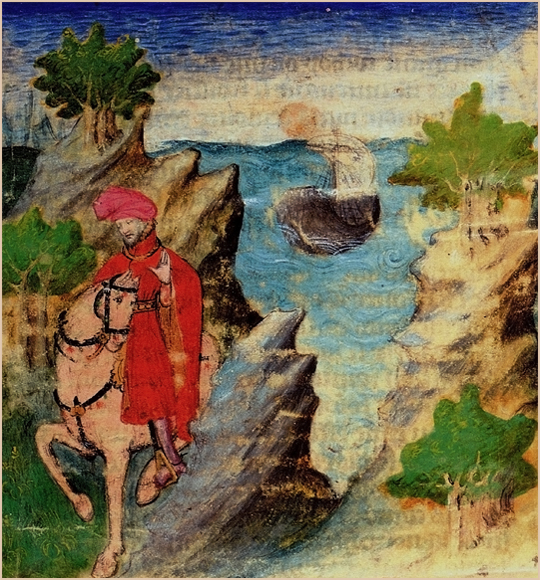
Thumbnail 3, folio 4
Sador, on horseback, follows a path over a cliff at the edge of the sea. Behind him the waves break and in the distance, a ship seems to be drifting. The knight drawn from the front turns his head with the intention of descending towards the sea. As he usually does in seascapes, the artist paints the sky in two tones: ultramarine in the upper part and very bright white in the lower part to highlight the horizon and give depth to the scene.
The fable of Tristan begins with the noble and handsome knight Sador, eleventh son of Bron and nephew of Joseph of Arimathea; the rightful custodians of the Holy Grail.
One fine day, meditatively strolling on horseback along the Cornish cliffs, Sador spots an aimless ship drifting in the distance. Alerted by what he sees in the distance, he decides to follow a path that will lead him to the sea.
Among the wreckage, Sador discovers a beautiful lady who, clinging to a wood, struggles exhausted among the waves. The knight rescues the mysterious lady, being immediately enchanted by her singular beauty, and takes her to his brother Nabuzadan's castle.
The lady claims to be a pagan princess, daughter of the King of Babylon, and tells how the ship that was to take her to the King of Persia, to whom she had been promised in marriage, is shipwrecked in a storm, being pushed to the shores of England. After recovering from the dramatic experience, the princess corresponds to the love of Sador; and, after embracing Christianity and being baptized with the name of Celinde, they both marry.
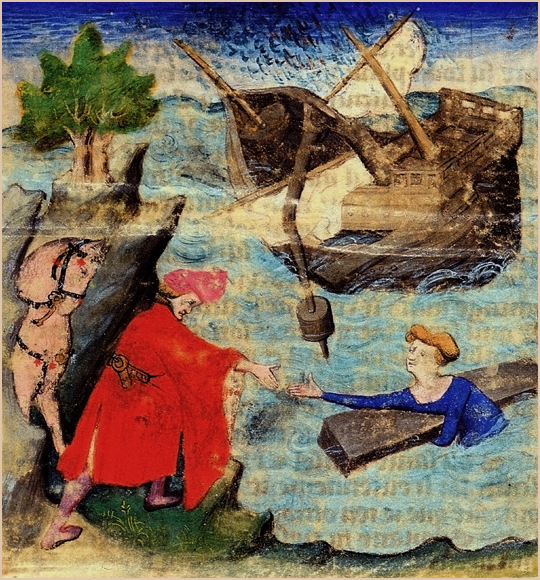
Thumbnail 4, folio 4
We have in this miniature a magnificent representation of a three-masted ship, dismantled by the waves. The center mast, which supported the lookout post, is submerged in the sea. The symbolic gesture of Sador, who holds out his hand to the shipwrecked woman, smiling and with perfectly combed hair, is very suggestive.

Thumbnail 5, folio 5
The scene is represented in a modest way. The bed is not unmade and Celinde is lying on it, dressed; her head rests on a pillow whose whiteness stands out against the red bedspread. The architecture of the bedchamber is purely symbolic; it is open to the outside through a window through which, instead of a landscape, we can see a colored and golden grid background, very frequent in the miniatures of the first decades of the 15th century.
One day, taking advantage of Sador's hunting trip, Nabuzadan, betraying his duty of hospitality and blinded by jealousy, bursts into Celinde's room and rapes her in spite of her refusal. Confessing what happened to her husband, Sador kills his brother to safeguard Celinde's honor, escaping with her on a ship bound for the court of Cornwall.
During the voyage a terrible storm breaks out, and a sorcerer on board claims that it is due to the fury of the gods for the fratricide of Sador. The crew mutinies and throws Sador overboard, causing the desolation of Celinde, who by then was already pregnant by her master. Sador manages to survive by swimming to an islet where he finds a hermit. He will remain there, in the company of the servant of God, for three years, without food, as atonement for his terrible crime.
Arriving at the court of Cornwall, Celinde is presented to King Thanor who, captivated by her unparalleled beauty, forces her to marry him. Soon after, Queen Celinde gives birth to Apollo, the son of Sador, whom Thanor abandons in the forest next to a fountain to be devoured by wild beasts, as a result of a soothsayer who predicts that when the child is older he will kill him by usurping the throne.
One day, King Pelias of Leonis, a neighboring kingdom of Cornwall, meets the beautiful Celinde when he is invited to the court of Thanor. Upon seeing her, he falls madly in love with her and unsuccessfully tries to kidnap her by breaking into the royal bedchamber.
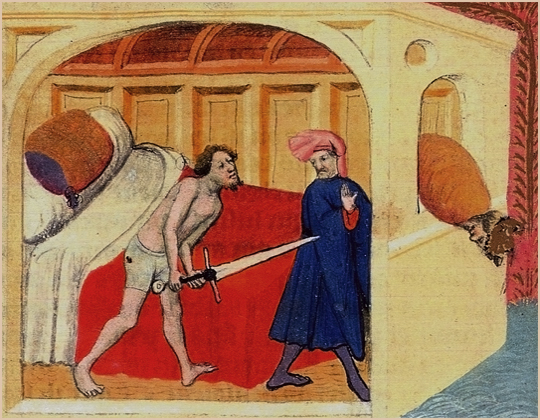
Thumbnail 6, folio 8
King Pelias, Thanor's guest, wanting to abduct Celinde, appears naked in the royal bedchamber where he thinks he will find her. There he kills the King's chancellor who arrives suddenly. Thanor, witnessing the drama, throws himself out of the window and falls into the water.
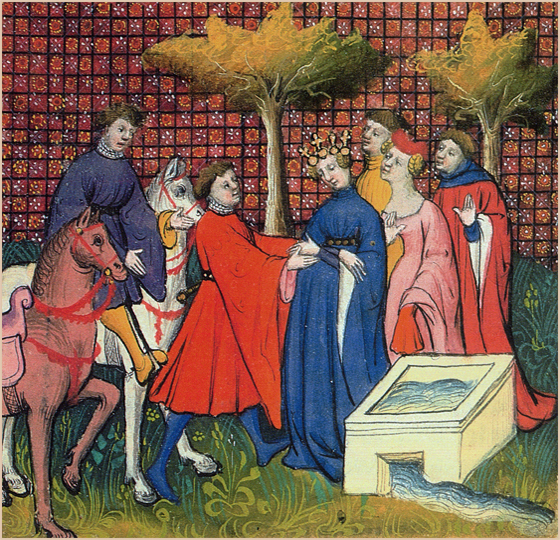
Thumbnail 8, folio 13
In a forest, Sador is recognized by Celinde. The scene takes place near a spring represented by a rectangular vessel from which a stream flows. Celinde is accompanied by a lady-in-waiting and two knights, and Sador by a rider holding his horse.
Sador, who after his return to Cornwall had been exiled to Leonis by Thanor, becomes paladin to King Pelias, who will tell him of his feelings for Thanor's wife, without Sador being able to suspect that it is actually his beloved Celinde.
Sador will help Pelias to kidnap Queen Celinde, but soon Celinde recognizes Sador and reveals her true identity. By means of a trick, Sador gets Pelias to return her to him, a circumstance that the lovers take advantage of to flee to the giant's forest.
After overcoming several tests in the form of riddles to which the giant subjects them, Sador and Celinde manage to escape, taking refuge in the castle of Triadan, an old magician. There, they will remain for more than fifteen years, enjoying their infinite love.
"Ma belle amie, ainsi est de nous:
Ni vous sans moi, ni moi sans vous".
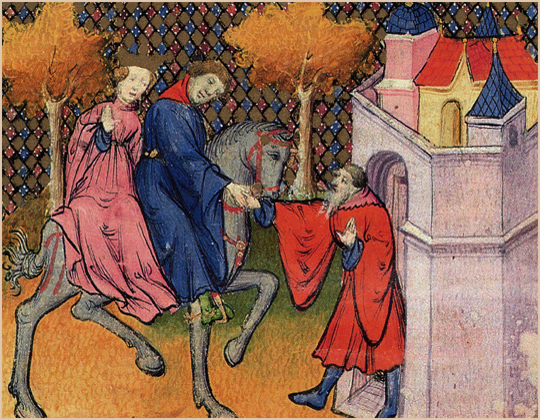
Thumbnail 9, folio 16
Sador carries Celinde on the back of his horse. Leaving the giant's forest, they arrive at a castle, owned by "Teriadan the enchanter". The owner of the castle greets them at the gate and immediately names Sador his heir. The trees are yellow, showing that the scene takes place in autumn.
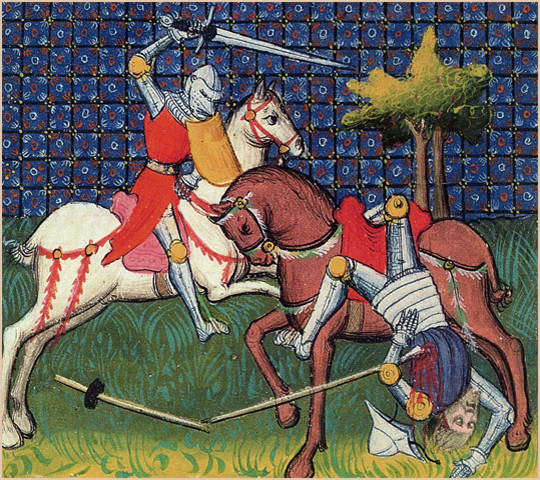
Thumbnail 9, folio 16
Apollo the Adventurer, son of Sador and Celinde, defies his own father without recognizing him. He knocks him out of the saddle and deals him a mortal blow. The face of the dying man, with closed eyes and open mouth, the horse's head and especially the helmet which, although it covers Apollo's face, shows his cruel expression, are truly representative of the fierceness and cruelty of the scene.
Years later, the couple is discovered by the King. In the heat of the battle, Thanor wounds Sador, but he survives. However, it is Apollo, the son of Celinde and Sador, who did not die when he was abandoned in the forest, who kills his father by mistake in a joust, believing that it is King Thanor. Later, Apollo will fulfill the prophecy by killing his real stepfather, thus proclaiming himself King of Leonis.
The nobles of the court exhort Apollo to take a wife, and to choose her, they bring him all the maidens and widows of the kingdom. Among them is Celinde. Apollo chooses her, and they share a bed and reign for a long time, without either of them really knowing who the other is. It will be St. Augustine who reveals to Celinde the unfortunate reality. The queen, without believing her words, orders the bishop to be imprisoned and executed; but when the executioners try to light the bonfire, the fire is extinguished, and a bolt from heaven strikes Celinde, who dies consumed by the divine fire.
CHELINDE, AETERNUS ET UMQUAM
Celinde represents the pagan influence in the Matter of Brittany, imbuing the protohistory of the Arthurian romance of Tristan and Iseo with an unearthly beauty and oriental sensuality. Her voluptuousness, eroticism and power of seduction evoke Isthar, the mountain star, goddess of beauty, love and fertility.
Celinde symbolizes ancient Babylon. She embodies feminine attributes typical of her Mesopotamian origin, treasuring a paradigmatic and timeless beauty thanks to the arts of the Adwiyat al-Zinah or "Medicine of Beauty", in the form of ointments, make-up and perfumed oils.
Celinde is the betrothed shipwrecked woman, the kidnapped bride, the raped wife, the polyandrous consort, the oedipal mother, the incestuous queen; but she is also the quintessence of tragic love, the white rose. Invoking the "traslatio regni et imperii", Celinde's inheritance in the imaginary of the Arthurian legend makes her forever a "unique lady among the unique".

OTHER PUBLISHERS
HAPPY VALENTINE'S DAY
The most romantic day of the year is coming, Valentine's Day. A day to celebrate love: that powerful and wonderful force, that deep and passionate feeling that unites two souls.
MERRY CHRISTMAS, PRINCESSES!
Christmas is a toast to love, it is to rediscover the child within you. A magical melody whose vibration resonates throughout the universe, as a hymn to hope, as an explosion of universal love.
HAPPY BEAUTY DAY
Festivity of all professionals who contribute to care for and beautify your skin, transcending stereotypes such as "ageism", and betting on a philosophy of utmost respect for health.



